�

�
Richard Norman's 298cid/4.9L Buick V8 Powered 1974 Lotus Elite
� as published in British V8 Newsletter, Volume XV Issue 1, April 2007�� Owner: Richard Norman
� � Model: 1974 Lotus Elite
� Engine: Buick V8
� Conversion performed by: Owner�
�
I bought my '74 Lotus Elite in 1982 with a slipped timing belt which had �
lunched all 16 valves in the 2.0 liter aluminum twin-cam 4 cylinder engine. �
On this engine, if the timing belt slips just one tooth it bends all of the �
valves, every time. The repair bill is about $2,000, or about $600 if you �
repair it yourself. I got the car for a good price and was just going to �
fix and resell it. The car came with low-grade cloth upholstery and cheesy, �
fake rosewood dash, door and console cappings. After only 28,000 miles the �
upholstery was shot. The original paint was an ugly brown. After I wasted �
a couple hundred bucks on advertising with no takers, I decided to do a �
makeover.�
�
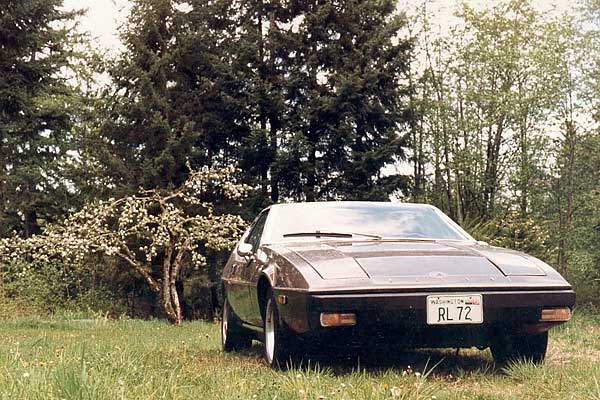
� Stock 1974 Lotus Elite�
�
�
Lotus's engine selection for the Elite was very unfortunate because the car �
already had great brakes, a race-tuned modern suspension, and glue-like �
tenacity on twisty roads. It is really a blast to drive - except for the �
lack of power.�
�
I thought about rebuilding the original Lotus engine for more power (with �
different cams, increased compression, better carburetors, etc.) but it is �
really a lousy and unrefined engine. It's noisy, rough, unreliable (the worst �
part, and typically British) and it's very expensive to rebuild. The engine �
can produce more power, and in later years Lotus turbocharged it and stroked �
it to 2.2L, but the joke is: if you look in the dictionary under "hand �
grenade"... there's a picture of the Lotus Turbo 2.2 engine. �
�
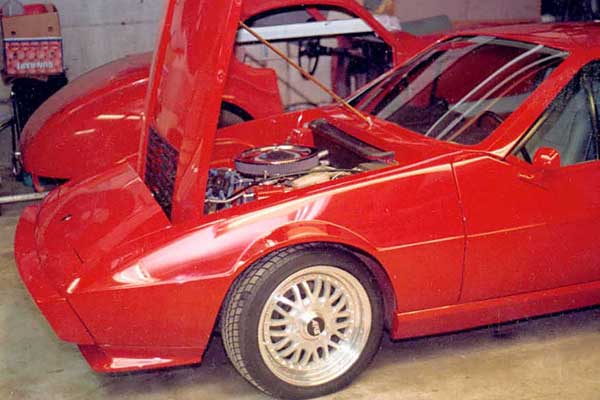
� Richard's Completed Lotus Elite V8 Conversion�
�
� I also thought the Buick 215 would be an excellent choice for the Lotus � because it's actually about 15 lbs lighter than the original all aluminum � 2.0 liter 4 cylinder twin cam engine! The Lotus engine's characteristics � were so bad that the car is really undesirable to many, including me. It � makes for a car that few people really want to own. With such a lightweight � engine for the transplant, I wouldn't add any weight to the front end and � ruin one of the best handling cars of all time, a car that started with a � 50/50 weight distribution. Lotus road cars have always been noted best for � the way their cars turn in and go around corners and in this respect the � Elite is one of the best road cars Lotus ever made. �
�
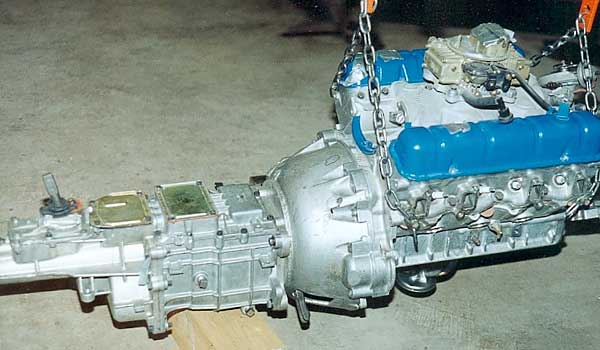
� Phil Baker Bored and Stroked Richard's Buick "215" to 298 cubic inches.�
�
� This is a very custom built engine with only the block and front engine � cover being used from the original 215 engine. Every other engine part � was borrowed from another engine, modified, custom fabricated or is a high � performance aftermarket part. Phil Baker has built many different � displacements using standard off the shelf parts to make them more � affordable than using custom ones. Experimenting with many different � parts and displacements to find out what works best, he has developed � much expertise with this engine and he had a stock pile of engines and � related parts. He has built many for racing as well as street.�
� When I met Phil, he was building a big block Keith Black hemi for the � street in his Dodge Challenger! Having friends like Mr. Black lets you � know a little of what kind of engine builder he is. He is a real gearhead � and knows his stuff. �
� I used the aluminum block of a '61 Buick 215cid, but with Buick's larger � 1964 300cid aluminum heads fitted with Manley (38mm) 1.496" (up from 1.313") � exhaust and TRW 1.723" intake (up from 1.625") valves. Chrysler 360 valve � springs were used. Using the 300's crankshaft increases the stroke from 2.8 � (71.1mm) to 3.4 inches (86.4mm). This makes a very noticeable increase in � torque. The crank was magnafluxed to check for cracks before any machining � commenced.�
� The engine has cast iron liners which were removed to be able to bore out � the block to accept larger Ohio 231 sleeves increasing the standard 215 bore � from 3.5 (88.9mm) to 3.736 inches (94.8mm). This allows the use of � standard-bore TRW forged-aluminum pistons from a Chevy 305cid with 10.25:1 � compression ratio. After a little massaging on the block for clearance, a � Small Block Chevy (327cid, '67 or earlier, two inch journal) connecting � rod was used. This increases torque because the pistons dwell at the top � of the cylinder longer, allowing more time for combustion, which increases � pressure on the piston. The stroke-to-rod ratio (1.67:1) is very close to � optimum. The "Childs and Albert" forged steel H-beam connecting rods were � shot-peened and chrome-moly tubular pushrods were fitted with standard � Buick 300 rocker arms. �
� The engine was carefully externally balanced and blueprinted with some � head porting to clean them up a bit. I had the tolerances machined closer � to the minus side as that is what you want in an all aluminum engine as things � tend to grow more when warmed up. I used all high end quality parts throughout � the engine like moly rings on the pistons and tool steel wrist pins and ARP � high strength rod bolts. �
� A Cloyes (Buick V6) pre-stretched double row, true roller timing chain was � used. Cloyes claims up to a 10hp gain with this timing chain which also � increases durability by using high quality billet steel heat-treated sprockets � with 3 keyways for more precise timing adjustments.�
� A number of years ago, I had a Triumph TR8 (Rover version of 215) whose timing � chain jumped 40 degrees while just starting the car because it had stretched � so much. If you are rebuilding a Buick 215 or Rover V8 engine, the Cloyes is a � great timing chain to use.�
�
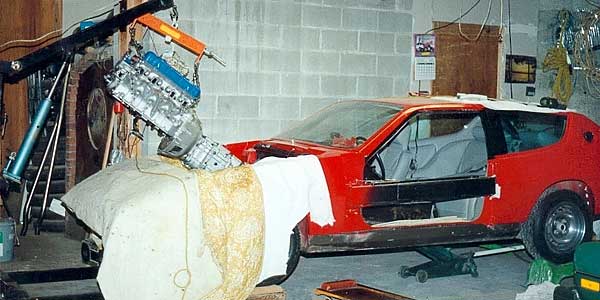
� Such a glove-like fit that the oil pan must be removed for engine installation.
� (Note: strong steel side beams tie into hidden rollover structure.)�
�
� A Crane "Hi-Intensity" hydraulic cam, grind number "HI-216/2852-29-12" was � matched to this engine giving 0.456" lift with 216 degrees duration on the � intake valves and 0.480" lift with 228 degrees duration on the exhaust, � measuring duration @ 0.050" lift. Lobe overlap is 115 degrees for the exhaust � and 109 degrees for the intake. The hydraulic lifters are designed to make � this cam variable as the lifters bleed off some oil for a reduction in lift � at low rpm (increases torque) but then it makes full lift on the valves at � higher rpm for more power. �
� He increased the diameter of the oil passage ways in the block and put in a � larger oil pickup and pickup tube. This engine likes lots of oil. A high � flow oil pump (not high pressure) and a larger high flow water pump were � employed as well.�
�
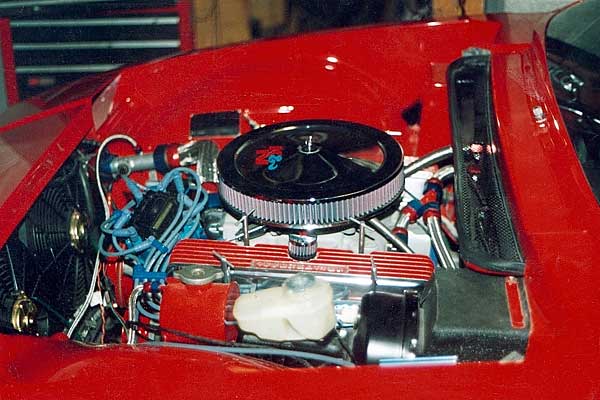
� Carter 600cfm four-barrel carburetor, topped with a 14x2 K&N Filter.�
�
� An Offenhauser 5165 single port four barrel intake especially made for the � 215 was port matched to the heads.�
� I used a Carter AFB four barrel 600cfm carburetor, which has slightly smaller � primaries than secondaries, and a throttle cable by Lokar. The smaller � primaries give better mileage cruising but the larger secondaries offer � good performance when you put your foot in it. Before I installed the new � rebuilt engine, I temporarily installed a spare block and heads with the new � transmission to fabricate the motor and transmission mounts and have a set of � custom built Tri-Y headers and exhaust system fit to the Lotus. This header � design is fabricated with 1-5/8" ID tubing. This is the optimum size for this � engine, any bigger and you lose torque, according to Phil. Four exhaust pipes � dump into two and then into one on each side. The length of the sections when � they are two is fairly long (about 20 inches) and this is what helps to makes � a broader torque curve especially at low rpm. It seems to be a great design � for the street, where torque is king. This increases the cylinder scavenging � effect and improves engine breathing by utilizing the exhaust velocity of one � cylinder to help the exhaust velocity of another. This helps pull in cleaner � air on the intake as well because more of the exhaust gases has been removed. � One advantage the Tri-Y has is the "step tube" effect. On each cylinder bank, � the four primary tubes collect into two secondary tubes that are usually two � sizes bigger in diameter. The two secondary tubes then collect into a single � outlet, which is usually two sizes bigger again. This increase in tube volume � slows the velocity of the gases, increasing the scavenging. The headers were � "Jet Hot" metallic ceramic coated to reduce engine bay temperatures and to � protect the headers from rusting. This coating dresses up the headers making � them look great and frees up about 10hp on this engine as it keeps the exhaust � gases hot to also help scavenge them. Stainless steel 2 inch dual exhaust � pipes were used from the headers back with stainless steel Super Trapp tunable � mufflers. The mufflers can be adjusted for noise, hp and torque. Using less � end cap diffusers makes it quieter with more back pressure for more torque or � you can add them which makes it louder and adds more top end horsepower. They � also affect lean and richness in the carburetor.�
� A 14" by 2" K&N air filter was used. It flows more air and traps more dirt � by using a reusable stainless steel mesh with surgical cotton gauze. A 1.5 � inch drop base air cleaner helps clear the low hood profile of the Lotus. �
� Stainless steel braided hoses and AN aircraft fittings were used throughout � the engine compartment, including the radiator hoses. Offenhauser polished � aluminum valve covers also really dress up the engine bay. �
� What about the charging system? A chrome 100 amp one-wire alternator with an � internal regulator was low-mounted onto the engine.�
�
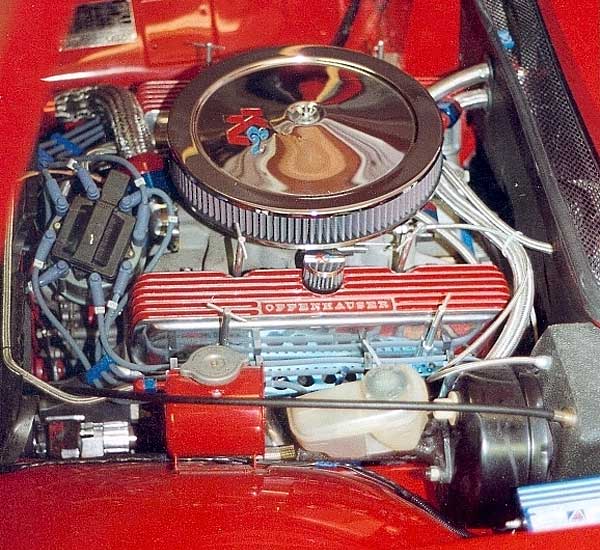
� 1974 Buick HEI distributor works with a Jacobs "Pro-Street Energy Pak" and "Ultra Coil".�
�
� Phil Baker carefully matched all the engine parts to work in harmony with � each other. He also re-curved the distributor to match the new engine � components for optimum power. (This engine likes 36 degrees of total timing.)�
� I used the best ignition I could find at the time, a Jacobs "Pro Street Energy � Pak" and "Ultra Coil". This is a computer controlled electronic ignition. This � is a really trick ignition and definitely one of the best you can use without � going to a distributor-less, multi-coiled unit. It uses what Dr. Christopher � Jacobs calls a "variable magnetic principle" ignition coil (replacing the coil � in the HEI distributor cap). This patented and unique ignition uses the spark � plugs as resistors measuring the load or need and adjusts the spark for intensity � and duration in each cylinder on each and every stroke for maximum efficiency. � The spark characteristics are always changing just like the fuel requirements � according to demand but few ignitions alter the spark. If the spark is too hot � or weak, then the gas mixture can sometimes not light off wasting that cylinders � power. This ignition eliminates all related problems including hesitations, � bogs, misfires and hot and cold starting related to weak ignitions. It makes � more power and eliminates misfires completely by re-firing the plug if the � mixture doesn't fire the first time. This noticeably increases gas mileage too. � At times, some new car ignitions misfire as much as 12 percent of the time � according to Dr. Jacobs, washing gas past the rings and into the oil and producing � absolutely no power in that cylinder while thinning the oil and increasing wear on � the cylinder walls, piston rings and engine bearings.�
� With this ignition, he claims around a 30 hp increase for a high performance � engine of this size (300cid) and has done road tests on a number of cars to prove � his point over stock OEM ignitions. I also used Jacobs's high performance 8.5mm � plug wires. �
� Because of this ignition, you can increase the plug gap for a larger (bigger is � better) spark kernel and also sometimes advance the timing as the gas ignites � and burns faster which also increases power and mileage. I also changed out the � stock ignition module for a high energy one. The module sits on the inside top � of the distributor. It's from Summit racing. They say it's so powerful it will � light up a small city! �
� According to Dr. Jacobs, the HEI is one of the best distributors out there so � these improvements make for a very good smooth running engine with maximum power � and mileage.�
� Jacobs puts out a manual called "Optimizing your Ignition". It's full of all � kinds of tricks to improve performance. Very useful! This ignition also improves � cold starting with a big 300 percent increase in energy to the plugs. The � computer makes 33 decisions for every 1.5 degree rotation of the engine or � about 8,000 decisions per revolution. At 6500 rpm redline, this is almost � 1 million a second, which is more than adequate to get the job done. �
�
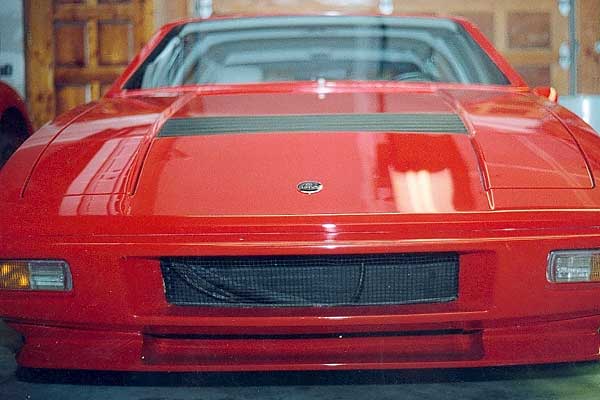
� Two Important Upgrades: Euro-Spec bumper and Electric Headlamp Tilt Mechanisms.
� (Note: Richard fitted Euro-spec bumpers front and rear, and a later "Series 2" Elite air dam.)�
�
� Lotus used a spring to lift the headlight pods open and a vacuum system to keep � them closed. They would only stay closed for about 12 hours after the engine � was turned off. To prevent them from opening, I discarded the whole Lotus � headlamp-lift system and replaced it with Triumph TR8 electric units. �
� Taking off the Elite's original air conditioning system saved 135 lbs all by � itself. I may find a lighter unit later. I took weight off any place I could. � Less weight is the same as more power and was Colin Chapman's philosophy in � all his cars, both racing and road.�
� I am using an "Optima" battery. It is a gel-cell which is lighter than a � conventional battery with more cold cranking power and should also last longer. � It also is totally sealed so there is no possibility of acid leaks or spills. � It doesn't emit fumes, which is important because it located inside the trunk. � I also fitted a heavier gauge battery cable for less voltage-drop to the starter. �
� I used a Holley electric fuel pump with a large Mallory fuel filter (both � re-located outside the trunk and away from the battery). The Elite was originally � fitted with plastic fuel line, so I replaced it with braided stainless steel hose � from the fuel pump (below the trunk) to a fuel pressure regulator with gauge on � the firewall close to the carburetor. I used "AN" aircraft-style fittings. (Many � Lotuses have burned up because of ruptured plastic fuel lines.) �
� A remote "System 1" race-developed anti-aeration oil filter that has over 138 � square inches of stainless steel pleated mesh for a life time of use was installed. � Any metal or foreign material that is floating around your engine (30 microns � or more) is trapped and easy to check for just by cleaning the re-useable filter � element. They claim it is the most technologically advanced filtration product � available with more surface area for higher flow and superior filtration than � other oil filters. The cast ribbed aluminum case strengthens the housing as well � as cools the oil almost as much as the radiator cools the engine coolant according � to the manufacture. AN #8 fittings with large stainless steel braided lines for � good flow were used. No more throwing away oil saturated used oil filters! �
� The oil pan was modified to hold 7 quarts of oil, for a total system capacity � of about 8.5 quarts.�
� I believe in using synthetic lubricants for all the drivetrain. In the engine � they provide more power, better gas mileage, better protection, and longer life. � Engines pollute less with synthetic lube. I used "Royal Purple" for the engine, � partly because it sticks better to bearing surfaces after engine shut down. I � used synthetic "RedLine" gear lube in the transmission and rear end. A friend � who races modified sprint cars (750+ hp small blocks) used to have to rebuild � his rear ends every year, but now with synthetic RedLine in his rear axle he � hasn't had a break down or worn out gears in a few years of racing.�
�
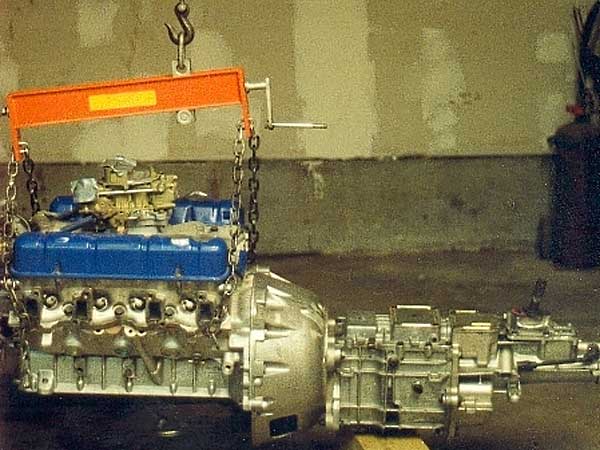
� Tremec 3550 5-speed heavy duty transmission.�
�
� I am now replacing the rear end, with its inboard rear drum brakes. They are � problematic and leak rear end fluid on to the brake shoes after only a few � thousand miles. Using inboard brakes is a great racing-derived design to reduce � the un-sprung weight that the rear suspension has to deal with, making the car � faster at handling the undulations in the road and also facilitating use of � lighter springs. This makes for a softer ride while still giving excellent � handling. Most Lotus cars have a good deal of wheel travel (up and down) and � a relatively soft and good ride while minimizing body roll for maximum handling � - the best of both worlds! With coil springs at all four corners, all � independently hung, adds to the Lotus touch for awesome handling.�
� The original rear end ratio of 3.7:1 with the Tremec 3.27 first gear makes � the overall ratio about 12.2:1 which would be great for drag-racing but it's� too low for the increase in power so I am trying to figure out what would be � the ideal ratio. I have found a rear-end that is both lightweight, strong and � is a quick change rear-end which means you can change the ratio easily and � quickly without taken the unit out of the car.�
� The engine was built to be a torque pig - which is what you want for the street! � With the proper gearing, I expect it to run 12 second quarter miles with 0-60 in � about 4 seconds and a sub 10 second 0-100mph. Top speed should be somewhere � around 190mph. �
� Because the increase in power from stock, I strengthened the trailing rear � suspension arms with some square tubing welded on each side. A new custom drive � shaft with stronger u-joints was also needed. The rear end half shafts will � also have larger and stronger u-joints and bigger wheel bearings on the outside � hubs next to the wheels.�
� In 1974 Road&Track didn't road test any car with a shorter stopping � distance than the Elite, so I am really looking forward to a very fun driver. � With all of the modifications I have made, the car has lost well over 100 lbs. � Nonetheless, I have decided to upgrade the brakes a little with larger diameter, � vented, slotted and cross drilled rotors all around and an adjustable � proportioning valve. I am going to Wilwood 12.8" rotors in front and 11" in the � rear. This should be more than adequate for the weight of the car. �
� So now, when the rear axle gets installed and new larger brakes, The Lotus � Elite will go, stop and look like it should have from the factory. �
�
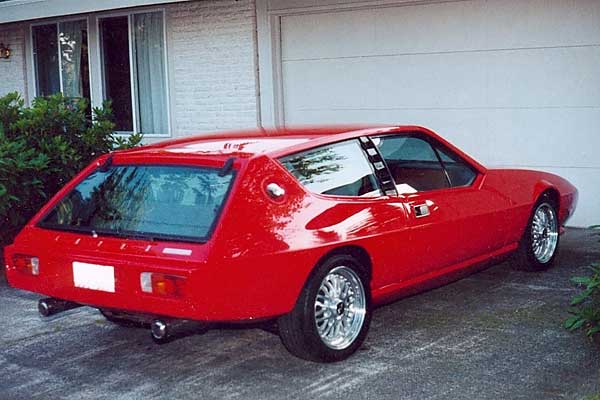
� The Lotus Elite is very slippery, with a drag coefficient of only 0.30.�
�
� The fiberglass boxes that make up the Elite's body are filled with foam, which � makes the car very stiff, light and tight which is one reason why it handles � so well. Lotus cars have always been at the head of the class in design innovations. �
�
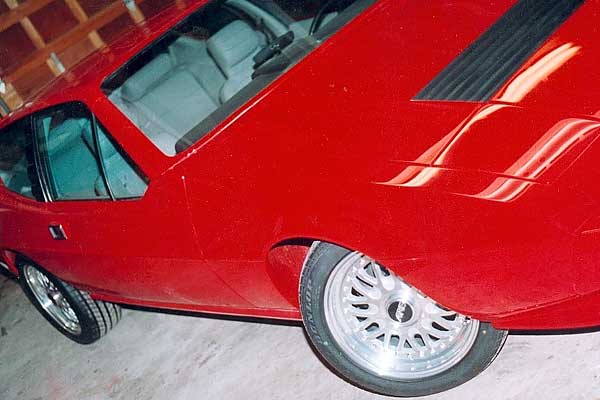
� Custom body and paintwork - including shaved marker lights and radio antenna.�
�
� My car originally came with Lotus's optional 14 inch aluminum alloy factory � wheels and 60 series tires (modern and low profile for 1974) but I changed to � 16 inch American Racing custom aluminum alloy wheels with Dunlop Sp Sport 8000 � 45 series Z-rated tires (205/45/16 front and 225/45/16 rear). The rear tires � are slightly larger (225mm) than original (205mm) to better handle the increase � in power. �
� The new trimmer (and lighter) European bumpers and front air dam greatly improved � the looks replacing the old federal big black rubber bumpers which did nothing � but make the car ugly, heavier and about 6 inches longer.�
� I sand blasted and straightened all of the ugly polished aluminum window moldings � and painted them body color along with the bumpers. This makes it look much better � and more modern. �
�
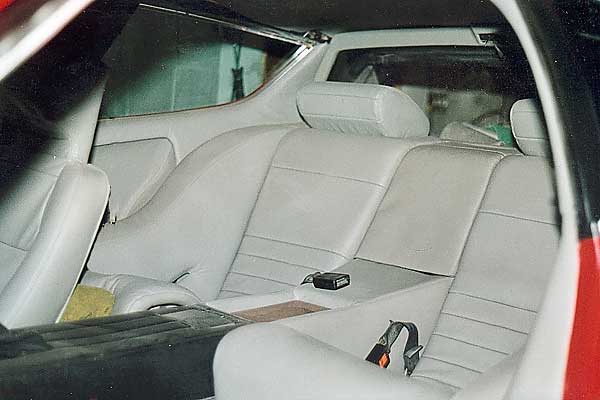
� Custom Connoly gray leather upholstery.�
�
� The Lotus does so many things right, but falls short in other areas so I have � modified its weak areas for a better car which is a lot more reliable and more � enjoyable to own. How many people don't buy British cars because of the � reliability factor, especially Lotuses? This car was weak in its electrics � (Lucas), engine, transmission, rear brake design and got a very poor grade in � the fit-and-finish department.�
�
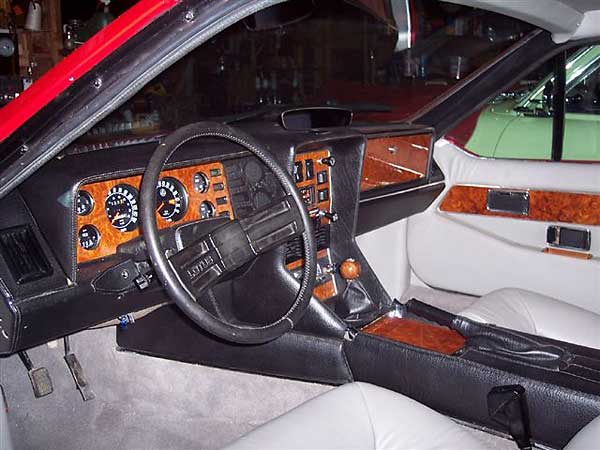
� Finishing Touches: burled Carpathian Elm dashboard inserts.�
�
� It has been a challenge to build and work on and has taken a long time (too � many interruptions) but should be a gas to drive which I hope to do again by � late spring or early summer of 2007.�
� The engine weights about 300 lbs with the parts I have used. That is one � lightweight, high performance engine, and perfect for sports cars! The car � weights a little over 2200 lbs with around 300 hp / 360 ft lbs torque. This � puts the power to weight at around 7 lbs/hp and a lot of torque throughout � the rev range so there is plenty of punch when ever you want or need it. With � the V8, I have greatly improved the power, reliability and fun, making the Lotus � much more desirable car for some real fun in the driving department. That is � the main reason we buy sports cars in the first place. By dressing up both � outside and inside also makes the car look so much better and makes the car so � much more enjoyable. It has been a fun but challenging project.�
� I've been told that the mid-engined Esprit was the car Mr. Chapman drove to � look good in, but the Elite was what he drove if he wanted to go have fun. This � car is a blast to drive as you can take corners faster than you ever thought � possible. It is so sure footed. It is difficult to get up enough nerve to � actually find the limit of adhesion in a corner but if you start to loose it � or drift, all you have to do is let off the throttle and it comes right back � to you. The car is very forgiving if you go too far overboard. You can � actually steer the car with the throttle. Now, my Elite will have power to � match its handling, with improved looks to boot! �
� �
�
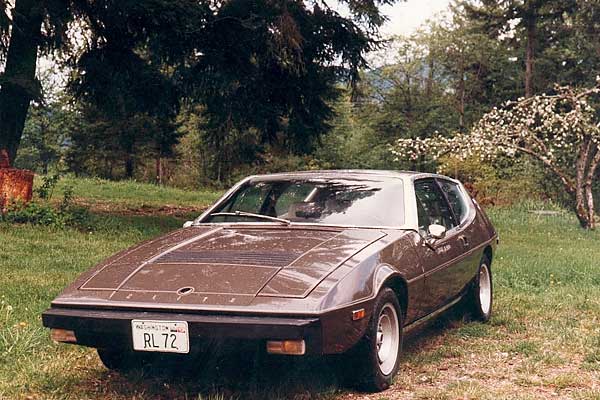
�
1974 Lotus Elite - Before the Engine Swap
�
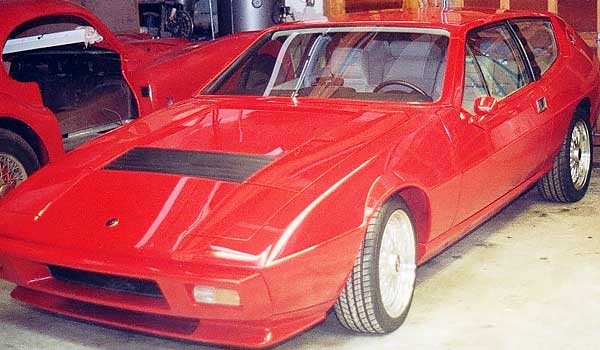
�
1974 Lotus Elite - After the Transformation
�
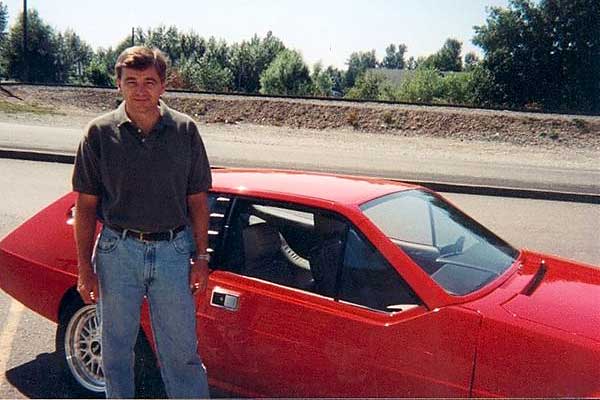
�
Richard Norman�

